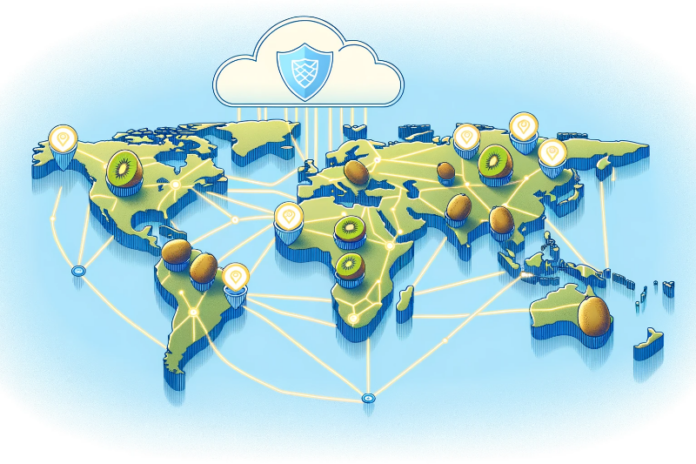Like any other enterprise during the pandemic, Zespri had to adopt remote work— which meant security-wise, there was an urgent matter to be dealt with.
Zespri operates out of 26 offices globally in order to serve more than 59 countries. This meant that securing the company’s network would no longer be confined to the four walls of the office.
“We realised the major need to protect ourselves and our core assets as best we can. While we had good tools and products installed, there was no strategic intent on how to optimise these tools consistently across our 26 locations, each with potentially varying IT setups,” shared Tim Lloyd, Head of Digital Operations at Zespri International.
In the past, the kiwi fruit marketer employed several security solutions from various vendors.
“Having varying solutions, particularly for a small team like mine, is difficult to manage and get the best outcomes. It’s hard to integrate solution A with solution B and solution C, and there’s a lack of visibility on the overall security posture,” Lloyd said.
Eliminating bottlenecks
One of Zespri’s main operational challenges was its long and complicated supply chain process, starting from kiwi cultivation, harvesting, and the post-harvest process, before distribution to retailers or customers worldwide.
Moreover, the supply chain process engages numerous legacy technologies and third parties, escalating Zespri’s security risk further.
Consequently, the company explored multiple options before deciding to partner with Palo Alto Networks.
“Superior proof of concept (POC) and great technical interactions are some other factors that influenced us to partner up with Palo Alto Networks for our cybersecurity needs,” Lloyd remarked.

Initially, Zespri deployed Palo Alto Networks’ “Next-Generation Firewalls,” both physically and virtually. After satisfying results, the kiwi fruit marketer also decided to use Palo Alto Networks’ Prisma SASE and Cortex XDR across the organisation.
“We also wanted to add resilience to our network while maintaining security and improving visibility. As a result, we chose and implemented Prisma SD-WAN globally with great success,” The Zespri executive continued.
To gain more agility, Zespri also wanted to extend its firewall strategy into the cloud, hence the extended partnership with Palo Alto Networks.
“We wanted to ensure we had that broader visibility and management, and that we were provided with improved cybersecurity protection for our wider ecosystem, especially as we expanded our cloud utilisation, which hadn’t been done previously,” Lloyd said.
Tailored solutions
Before deployment, Palo Alto Networks carefully studied Zespri’s multinational operations, as well as the multiple solutions the latter was currently using.
To ensure consistent security across Zespri’s footprint, Palo Alto Networks leveraged an integrated solution. It aimed at providing a broader view of threats and managing them, integrating various products, as well as facilitating automation, a consistent user experience, and easier deployment, explained Misti Landtroop, New Zealand Managing Director, Palo Alto Networks.

Landtroop outlined four common security challenges for enterprises in the agriculture industry:
- Various unidentified and unsecured vulnerable assets: These assets may include sensitive data in unknown locations, websites with a direct or indirect path to the organisation, misconfigured user credentials, and previously used SaaS applications that are no longer in use.
- Increased attack surface: Digital transformation is blurring the lines between IT and OT used in industries. The widespread adoption of IoT devices in various sectors, including agriculture, has led to a significant increase in the number of connected devices. Each device represents a potential entry point for cyberattacks.
- Legacy systems: Many OT systems are built on legacy technologies not designed with cybersecurity in mind. These systems are often challenging to update or secure, creating additional challenges.
- Long supply chain process, with multiple IT and OT infrastructures involved: When organisational departments operate in silos, this further elevates the security risk.
“A trend that we have noticed is that, since the pandemic, remote work and the use of personal devices have surged, exponentially elevating cybersecurity risk for businesses,” Landtroop said.
Bagful of benefits
Following its collaboration with Palo Alto Networks, Zespri now has enhanced security for its critical assets across all its offices.
“The adoption of Palo Alto Networks’ solution also led to better visibility over our entire network. Our cybersecurity measures have become more targeted, especially in handling the volume of incidents, helping us differentiate between near-misses and actual incidents, and prioritising the latter. Our business has moved to a point where we frequently encounter no actual security incidents, only some near misses,” Lloyd said.
Further, cross-data insights have sped up investigations and streamlined the process of incident response and recovery, enabling Zespri’s security team to quickly identify and resolve issues.
“A notable observation by our security team is the reduction in logged tickets, indicating that this solution is more stable compared to the previous one. An additional benefit is the deeper insight into user behaviour; we can now more accurately identify unusual activity and engage with the user directly instead of sifting through logs or discovering issues later. The entire process has become much more real time as now we can clearly and articulately identify where we need to focus our time,” the Zespri executive noted.
Lloyd also mentioned a significant cost-saving, stating that the company managed to save at least NZ$500,000 annually with just the Prisma SD-WAN solution, developed and designed by internal staff and a trusted independent consultant, with Palo Alto Networks’ support.
Looking ahead, Zespri aims to continue offering more value to its growers, improve business efficiencies, and stimulate demand in its markets.
“We have many core solutions to support these goals. However, for new advancements, a blend of automation, data science, and generative AI will be essential to help us stay ahead of the game and unlock value. Along with this, we are looking for new ways to simplify and better serve our digital user base, both internally and externally,” he concluded.
















